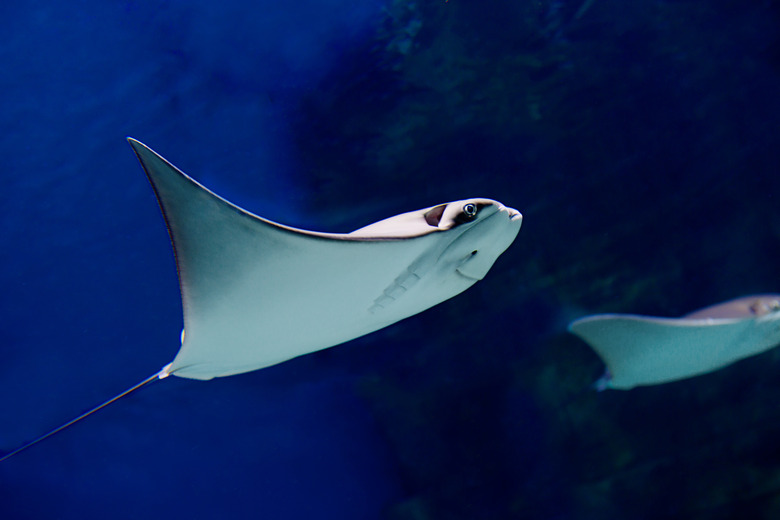What Are The Adaptations Of A Stingray?
Stingrays live in sandy marine environments. These gentle creatures are known for their odd looks: they have flattened dorsal fins, disc-shaped bodies and eyes on top of their heads. These are adaptations, or changes in the species over time that have allowed them to survive in their environment. Some of the stingray's adaptations allow it to be a better predator, while others allow it to conserve energy and hide from predators.
Senses
Senses
Stingrays have eyes on their dorsal or top surface, which allows them to see prey moving above them while they are hiding in the sand. They also have good low-light vision. However, since stingrays can only see the areas above and around their bodies, they have developed good senses of touch and smell to find food. Their mouths are located on their undersides, allowing them to feed on creatures that live on the ocean floor.
Prey Sensing
Prey Sensing
Stingrays have other specialized senses to help them find food. They have a closed lateral line system on their dorsal surface that can detect the streams of water given off by oysters and other bivalves. They also have electroreception abilities. Every animal has an electrical energy field around it due to electrical activity or charges in its body. Stingrays can detect this electricity with their electrosense, making it a valuable adaptation for finding prey hidden in the sand.
Buoyancy
Buoyancy
Stingrays lack the swim bladder and oil-filled liver that make fish buoyant. As a result, they start to sink when they aren't swimming. However, the stingray's flattened body and pectoral fins help them glide through the water. Due to their lack of buoyancy, stingrays can sink to the ocean floor and hide from predators in the sand for long periods. These adaptations for gliding and hiding beneath the sand allow the stingray to conserve energy, which in turn allows them to eat less.
Breathing
Breathing
Stingrays breathe underwater, but they don't take water in through their mouths and pump it through their gills like fish do. Instead, they have spiracles — openings for gas exchange — behind their eyes, and their gills are on their flat underside. Water goes in through the spiracles and out through the gills, freeing the stingray's mouth to eat. This arrangement also allows the stingray to breathe while covered in sand.
Cite This Article
MLA
Gambrel, Ellie. "What Are The Adaptations Of A Stingray?" sciencing.com, https://www.sciencing.com/adaptations-stingray-8273968/. 13 March 2018.
APA
Gambrel, Ellie. (2018, March 13). What Are The Adaptations Of A Stingray?. sciencing.com. Retrieved from https://www.sciencing.com/adaptations-stingray-8273968/
Chicago
Gambrel, Ellie. What Are The Adaptations Of A Stingray? last modified August 30, 2022. https://www.sciencing.com/adaptations-stingray-8273968/
